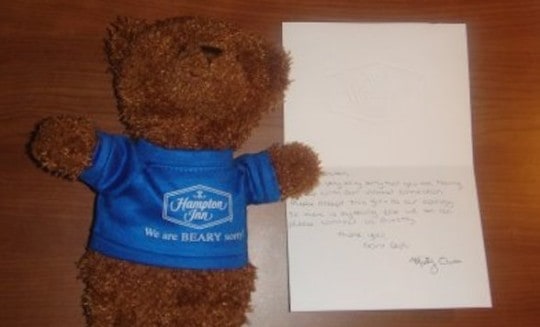Making the Most Of Customer Complaints – WSJ.com:
Here's a good article from the WSJ about customer focus and quality improvement:
“All too often, companies have customer service sort out the immediate problem, offer an apology or some compensation, and then assume all is well. This approach is particularly damaging because it does nothing to address the underlying problem, practically guaranteeing similar failures and complaints.”
Of course, if you're just putting the fire out without looking for a root cause or for prevention, you're going to have the same problem occur again. It seems that many organizations respond to each problem (overreact even) as if it's a “special cause” when the problem is really a “common cause” that's a result of some underlying process or system. The article continues:
“The chief aim of managers in service recovery is to help the company learn from service failures so it doesn't repeat them. Learning from failures is more important than simply fixing problems for individual customers, because process improvements increase overall customer satisfaction and thus have a direct impact on the bottom line.”
That starts sounding like a Lean mindset — a ” kaizen” approach even. There are many examples in the book Lean Solutions (including Fujitsu) where companies were able to turn complaints into the starting point for a real process improvement process. The goal of any complaints department should be to help initiate improvements that drive future complaints to zero.
If employees aren't allowed to help improve the process, they may take a turn for the worse after getting frustrated with the continued complaints:
“Even though complaining customers represent an opportunity to fix problems and improve satisfaction, alienated employees often see them as the enemy. In a study of a major European bank, employees in Switzerland consistently indicated that they did not consider reports of missing account statements to be complaints. As one said: “These things happen. There is nothing we can do about that.”
One way to keep employees engaged and serving customers is to give them some freedom:
“Ritz-Carlton, for example, the luxury brand of Marriott International Inc., authorizes personnel at the front desks of its hotels to credit unhappy customers up to $2,000 without asking a supervisor's approval. On the other hand, in one of our consulting projects, a client reacted very negatively to this approach, claiming that such a policy would be too expensive for his company. We replied that the high cost of poor service is exactly what makes this system work so well: It forces management to eliminate service failures in the first place.”
Just recently, I complained to a Hampton Inn I was staying at in Illinois (and was booked to stay at again for multiple weeks). The “high-speed” wireless internet service was the furthest thing from high-speed. I complained the first night and the hotel was unable to fix anything. The second night, I called the 800 tech support number and they were unable to fix anything. The third and final night, I received this in my room after complaining and pointing out that I'd have to choose a different hotel for my future weeks if they didn't have good internet access:

It's a bear that says “Beary Sorry” with the Hampton Inn logo on it. Oh, and there was a nice (I suppose) handwritten personal apology note. OK, warm fuzzy feeling. But it did nothing to fix the problem. It did nothing to say what they were going to do to improve the internet access for the next stay.
In fact, having these bears laying around implies that they have so many customer service complaints that they had the special bears made up. It's too bad they can't invest that cash and time into improving the actual service. I'm not going to stay there again just because they gave me a bear.
After canceling my future reservation, I got a voice mail from someone at the hotel. They apologized (again!) for the problem and said they were taking one night's worth of charges off of my bill. OK, great, they are saving my employer some money. But that doesn't tell me what they're doing to fix the problem and doesn't make any sort of case for why I should stay there again.
Basically, they just threw away $129 of revenue. If they had talked to me live and asked what I wanted, “give me a refund” would have been the last thing out of my mouth. You see this a lot on the TV show “Kitchen Nightmares” (now into it's second season). Some manager is comping guests when there's a problem — free appetizer, free dessert, etc. As the WSJ article (and my experience) showed — it's doing nothing to actually fix the problem if you're giving away free desserts every night instead of fixing the underlying problem.
Do you have similar experiences, as a customer or in your business?
Please scroll down (or click) to post a comment. Connect with me on LinkedIn.
Let’s work together to build a culture of continuous improvement and psychological safety. If you're a leader looking to create lasting change—not just projects—I help organizations:
- Engage people at all levels in sustainable improvement
- Shift from fear of mistakes to learning from them
- Apply Lean thinking in practical, people-centered ways
Interested in coaching or a keynote talk? Let’s start a conversation.









![When Was the Last Time a Leader Around You Admitted They Were Wrong? [Poll]](https://www.leanblog.org/wp-content/uploads/2025/07/Lean-Blog-Post-Cover-Image-2025-07-01T212509.843-100x75.jpg)
Well said Mark and ditto that.
I have a director over a large outpatient service line who is very active in addressing complaints as well as recognizing staff whenever a compliment comes in. I personally have had errors in their service and got some gratuitous apologies but know for a fact that nothing was done behind the scenes to make sure the same problem never happened again to another patient.
It seems the director believes that immediate response is sufficient to address the problem.
Hi Mark.
How true. But at least you received an apology. What about the Sprint 1,000 who received ‘Dear John’ letters from Sprint for being too expensive to service, even though it appears that the majority of costs were caused by Sprint’s woefully inadequate customer service in the first place.
Faced with a whole range of actions to resolve the costs issue, Sprint chose perhaps the least intelligent way out. And incurred no end of other costs as a result.
Sprint Fires its Unprofitable Customers
http://www.customerthink.com/blog/sprint_fires_its_unprofitable_customers
Graham Hill
Independent CRM Consultant
Interim CRM Manager
PS. Saw you were a judge at the Strategic Manufacturing Awards I attended in Duesseldorf last week. Interesting list of awardees.
This is part of a broader malign trend in American business (and American society as a whole)–WORDS are viewed as the primary reality, much more important than the things the words are about. Thus, it is more important to make the right verbal gestures of apology than to actually fix the problem.
This phenomenon can be observed in many call centers, where the precise words that the agent must use are carefully Taylorized, but no one seems to have actually thought through the problem-solving procedures in any depth.
Graham – that’s cool that you saw that. I still haven’t seen the full list of winners. What was interesting about the list of winners, to you?
Hi Mark,
Not to criticize your entry but I thought one of the most salient lines in the WSJ article was:
"Managers in charge of service recovery, meanwhile, can feel pressure to limit flows of critical customer comments, even though acting on the information will improve efficiency and profits."
because these behaviors promote an environment of “first order processing” encouraging an atmosphere of heroism from people on the front lines. The problems this creates was most clearly illustrated (to me) by Tucker, Edmondson and Spear in their article _Why Your Organization Isn’t Learning All It Should_ based on their study of problem resolution strategies employed by nurses. I don't know if links work here but that article is here:
http://hbswk.hbs.edu/item.jhtml?id=2397&t=strategy
My interpretation of the authors analysis, applied in a manufacturing environment is here:
http://www.fashion-incubator.com/archive/problems_in_problem_prevention/
I think you have to consider that Hampton Inn has already done the analysis on customer retention vs. investment in higher-speed internet. Someone may have performed the cost/benefit analysis that looked at the cost of losing a certain segment of customers (such as business travelers without Blackberries requiring highspeed internet access) vs. the cost to upgrade the technology in their hotels. Not that I agree with this, but it’s a possibility that shouldn’t be ruled out.
Jason — interesting point. It could be a possibility, but I’d also think it would be pretty dumb of them to make that choice, considering how important internet access is to many business travelers (a group that’s Hampton’s primary market).
I did get a follow up call from the hotel and they said they DID have someone who visited to check out and improve their internet connection…. so we’ll see.
As it turns out, Hampton not only refunded one night, but the ENTIRE STAY. That was $590 they just threw back. Surprising.
Great piece. I know it’s fairly old, but I came in through a link on another blog as it seemed relevant and interesting.
I like how simply you laid this out. Now if companies would act on it all that time and energy they’d “waste” to fix the problem would most likely clear up lots of time and energy from performing “make goods”.
Most of the time I feel the same way, don’t comp me something – fix the issue. I had a similar round of interesting events happen at a recent hotel. “Sorry” was all they offered. No fixes, no actual action.
I’ll definitely be looking for a different chain next trip.